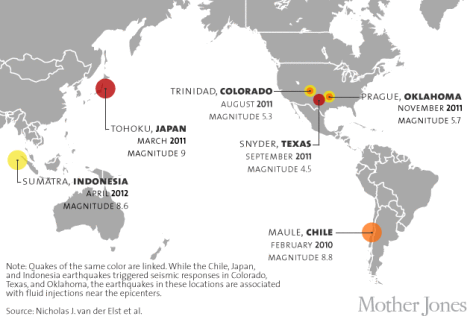By SEAN COCKERHAM
McClatchy Washington Bureau May 1, 2014
WASHINGTON — The swarm of earthquakes went on for months in North Central Texas, rattling homes, with reports of broken water pipes and cracked walls and locals blaming the shudders on the hydraulic fracturing boom that’s led to skyrocketing oil and gas production around the nation.
Darlia Hobbs, who lives on Eagle Mountain Lake, about a dozen miles from Fort Worth, said that more than 30 quakes hit from November to January.
“We have had way too many earthquakes out here because of the fracking and disposal wells,” she said in an interview.
While the dispute over the cause remains, leading geophysicists are now saying Hobbs and other residents might be right to point the finger at oil and gas activities.
“It is certainly possible, and in large part that is based on what else we’ve seen in the Fort Worth basin in terms of the rise of earthquakes since 2008,” William Ellsworth, a U.S. Geological Survey seismologist, said in an interview Thursday.
Ellsworth said the Dallas-Fort Worth region previously had just a single known earthquake, in 1950.
Since 2008, he said, more than 70 have been big enough to feel. Those include earthquakes at the Dallas-Fort Worth airport that scientists linked to a nearby injection well.
Ellsworth briefed his colleagues on his findings Thursday at the Seismological Society of America’s annual meeting in Anchorage.
Researchers also are investigating links between quakes in Kansas, Oklahoma, Ohio and elsewhere to oil and gas activities. USGS seismologist Art McGarr said it was clear that deep disposal of drilling waste was responsible for at least some of the quakes in the heartland.
“It is only a tiny fraction of the disposal wells that cause earthquakes large enough to be felt, and occasionally cause damage,” McGarr said. “But there are so many wells distributed throughout much of the U.S., they still add significantly to the total seismic hazard.”
While causes are under debate, it’s established that earthquakes have spiked along with America’s fracking boom. The USGS reports that an average of more than 100 earthquakes a year with a magnitude of 3.0 or more hit the central and eastern U.S. in the past four years.
That compares with an average rate of only 20 observed quakes a year in the decades from 1970 to 2000.
Regulators in Ohio found what they said was a probable connection between small quakes in the northeast corner of that state and the process of hydraulic fracturing, or fracking, in which high-pressure water and chemicals are pumped underground to break up shale rock and release the oil and natural gas inside.
But the USGS considers it very rare for fracking itself to cause earthquakes. Far more often the issue is quakes caused by the disposal of the wastewater into wells.
Fracking produces large amounts of wastewater, which companies often pump deep underground as an economical way to dispose of it. Injection raises the underground pressure and can effectively lubricate fault lines, weakening them and causing quakes, according to the USGS.
USGS seismologist Ellsworth said that near Fort Worth, two disposal wells were close enough to the earthquakes to be responsible. He said more research was needed.
Ellsworth and his colleagues, including seismologists from Southern Methodist University, in their presentation Thursday ruled out the idea that the falling level of a nearby lake might be contributing. But he said they couldn’t entirely reject the possibility of other natural causes — despite earthquakes being virtually unheard of in the region before 2008, which matches the start of the fracking boom.
Hobbs, of Eagle Mountain Lake, Texas, said she’d lived in the area since 1967 and never even considered the possibility of earthquakes.
“It’s spooky,” she said.







